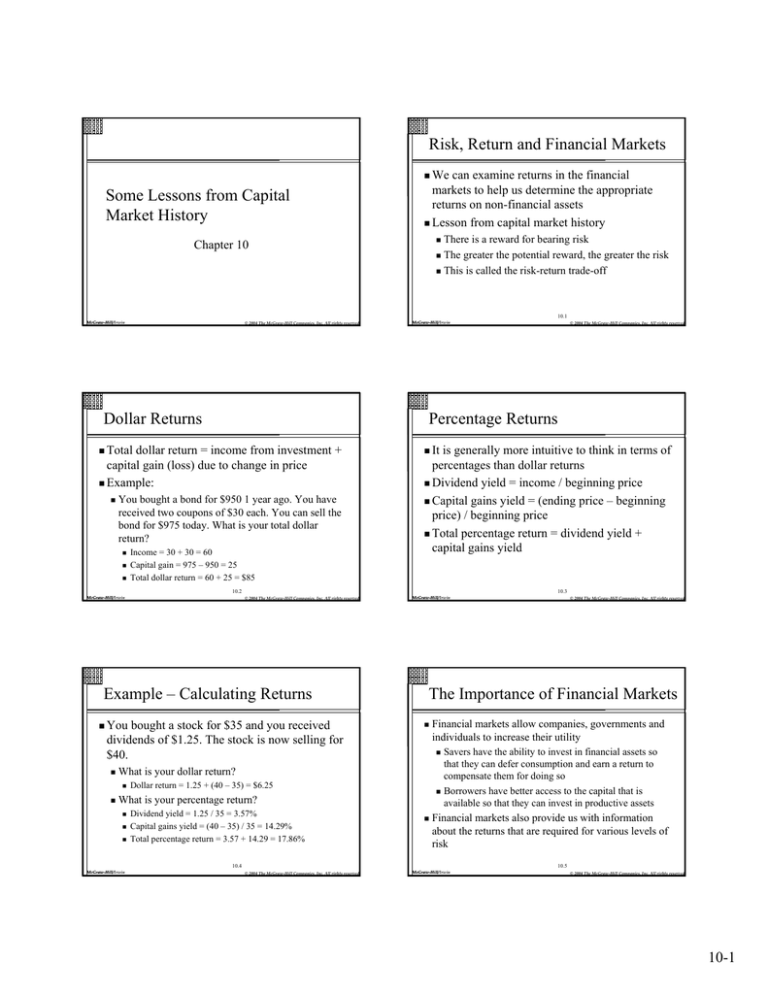
Risk, Return and Financial Markets
We
Some Lessons from Capital
Market History
can examine returns in the financial
markets to help us determine the appropriate
returns on non-financial assets
Lesson from capital market history
There is a reward for bearing risk
The greater the potential reward, the greater the risk
This is called the risk-return trade-off
Chapter 10
10.1
McGraw-Hill
McGraw-Hill/Irwin
© 2004 The McGraw-Hill Companies, Inc. All rights reserved.
Dollar Returns
dollar return = income from investment +
capital gain (loss) due to change in price
Example:
You bought a bond for $950 1 year ago. You have
received two coupons of $30 each. You can sell the
bond for $975 today. What is your total dollar
return?
Income = 30 + 30 = 60
Capital gain = 975 – 950 = 25
Total dollar return = 60 + 25 = $85
It
is generally more intuitive to think in terms of
percentages than dollar returns
Dividend yield = income / beginning price
Capital gains yield = (ending price – beginning
price) / beginning price
Total percentage return = dividend yield +
capital gains yield
10.2
McGraw-Hill
McGraw-Hill/Irwin
10.3
© 2004 The McGraw-Hill Companies, Inc. All rights reserved.
Example – Calculating Returns
You
bought a stock for $35 and you received
dividends of $1.25. The stock is now selling for
$40.
What is your dollar return?
What is your percentage return?
McGraw-Hill
McGraw-Hill/Irwin
Financial markets allow companies, governments and
individuals to increase their utility
Savers have the ability to invest in financial assets so
that they can defer consumption and earn a return to
compensate them for doing so
Borrowers have better access to the capital that is
available so that they can invest in productive assets
Dollar return = 1.25 + (40 – 35) = $6.25
Dividend yield = 1.25 / 35 = 3.57%
Capital gains yield = (40 – 35) / 35 = 14.29%
Total percentage return = 3.57 + 14.29 = 17.86%
© 2004 The McGraw-Hill Companies, Inc. All rights reserved.
The Importance of Financial Markets
Financial markets also provide us with information
about the returns that are required for various levels of
risk
10.4
McGraw-Hill
McGraw-Hill/Irwin
© 2004 The McGraw-Hill Companies, Inc. All rights reserved.
Percentage Returns
Total
McGraw-Hill
McGraw-Hill/Irwin
10.5
© 2004 The McGraw-Hill Companies, Inc. All rights reserved.
McGraw-Hill
McGraw-Hill/Irwin
© 2004 The McGraw-Hill Companies, Inc. All rights reserved.
10-1
Average Returns
Risk Premiums
Investment
Average Return
Large stocks
12.7%
Small Stocks
17.3%
Long-term Corporate Bonds
6.1%
The
“extra” return earned for taking on risk
Treasury bills are considered to be risk-free
The risk premium is the return over and above
the risk-free rate
Long-term Government Bonds 5.7%
U.S. Treasury Bills
3.9%
Inflation
3.1%
10.6
McGraw-Hill
McGraw-Hill/Irwin
10.7
© 2004 The McGraw-Hill Companies, Inc. All rights reserved.
Historical Risk Premiums
Large
stocks: 12.7 – 3.9 = 8.8%
Small stocks: 17.3 – 3.9 = 13.4%
Long-term corporate bonds: 5.7 – 3.9 =1.8%
Long-term government bonds: 5.7 – 3.9 = 1.8%
McGraw-Hill
McGraw-Hill/Irwin
Efficient Capital Markets
Stock
prices are in equilibrium or are “fairly”
priced
If this is true, then you should not be able to
earn “abnormal” or “excess” returns
Efficient markets DO NOT imply that investors
cannot earn a positive return in the stock market
10.8
McGraw-Hill
McGraw-Hill/Irwin
10.9
© 2004 The McGraw-Hill Companies, Inc. All rights reserved.
What Makes Markets Efficient?
There
are many investors out there doing
research
As new information comes to market, this
information is analyzed and trades are made based
on this information
Therefore, prices should reflect all available public
information
If
investors stop researching stocks, then the
market will not be efficient
McGraw-Hill
McGraw-Hill/Irwin
© 2004 The McGraw-Hill Companies, Inc. All rights reserved.
Common Misconceptions about
EMH
Efficient markets do not mean that you can’t make
money
They do mean that, on average, you will earn a return
that is appropriate for the risk undertaken and there is
not a bias in prices that can be exploited to earn excess
returns
Market efficiency will not protect you from wrong
choices if you do not diversify – you still don’t want to
put all your eggs in one basket
10.10
McGraw-Hill
McGraw-Hill/Irwin
© 2004 The McGraw-Hill Companies, Inc. All rights reserved.
10.11
© 2004 The McGraw-Hill Companies, Inc. All rights reserved.
McGraw-Hill
McGraw-Hill/Irwin
© 2004 The McGraw-Hill Companies, Inc. All rights reserved.
10-2
Strong Form Efficiency
Prices
reflect all information, including public
and private
If the market is strong form efficient, then
investors could not earn abnormal returns
regardless of the information they possessed
Empirical evidence indicates that markets are
NOT strong form efficient and that insiders
could earn abnormal returns
Semistrong Form Efficiency
Prices
reflect all publicly available information
including trading information, annual reports,
press releases, etc.
If the market is semistrong form efficient, then
investors cannot earn abnormal returns by
trading on public information
Implies that fundamental analysis will not lead
to abnormal returns
10.12
McGraw-Hill
McGraw-Hill/Irwin
10.13
© 2004 The McGraw-Hill Companies, Inc. All rights reserved.
McGraw-Hill
McGraw-Hill/Irwin
© 2004 The McGraw-Hill Companies, Inc. All rights reserved.
Weak Form Efficiency
Prices
reflect all past market information such
as price and volume
If the market is weak form efficient, then
investors cannot earn abnormal returns by
trading on market information
Implies that technical analysis will not lead to
abnormal returns
Empirical evidence indicates that markets are
generally weak form efficient
10.14
McGraw-Hill
McGraw-Hill/Irwin
© 2004 The McGraw-Hill Companies, Inc. All rights reserved.
10-3




